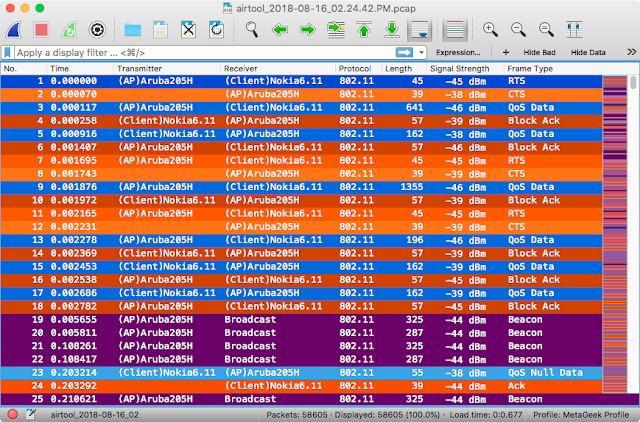

Don't Miss: Hack 5 GHz Wi-Fi Networks with an Alfa Wi-Fi Adapter.It could be a suspicious rogue access point that appears at your place of work, a new network with a strong signal that shows up at your home, or a Wi-Fi hotspot from a smartphone that seems unusually close and strong. If you've ever seen a Wi-Fi network that doesn't belong, you might wonder if there is a way to track down where it's coming from. By sweeping the antenna back and forth, we can easily discover which direction the signal is coming from by looking for spikes in signal strength on the graph. Using a directional Wi-Fi antenna and Wireshark, we can create a display filter to target any device in range to plot the signal strength on a graph. It can show where there might be issues with a TCP connection, such as timeouts, re-transmitted frames, or dropped connections.If you've ever wanted to track down the source of a Wi-Fi transmission, doing so can be relatively easy with the right equipment. The flow graph feature can provide a quick and easy to use way of checking connections between a client and a server. Figure C is a sample of how the text data file looks. Of course, not everyone is the same, and many people prefer the GUI graph. The actual data is the same, but the text file is quite easy to use as a substitute for a picture file. As a long term (or maybe long time) CLI user, this is a feature I particularly like.

You can also step through the graph to the end and see if there are any re-transmits due to packet loss or timeouts.Ī further feature of Wireshark is that you can save the flow graph in text file format. We can see, for instance, the time of transmission, the size of the frame, the sequence number of the frame and the TCP ports used for the connection. The essential details of a frame are shown in the flow graph. Once the connection is established, the data frames start to flow. Figure B click to enlarge.įigure B shows the connection initiation process between the server and the client. Click OK and the graph will appear as shown in Figure B. Figure A Click to enlarge.įrom the popup window, select Display Packets, TCP Flow, and Standard source/destination address. Then (on the main menu) you can click on Statistics, then down to Flow Graph. In this case, I wanted to check the connection from start to finish, so I picked the first SYN packet. Firstly, you should locate the start of the connection. It is pretty simple to bring up the flow graph. The flow graph feature shows a sender and a receiver view of the packet flow. For this example, I used the filter ip.addr=192.168.250.102 and clicked Apply.įrom there, you can do the next trick, which is to look at the flow graph of a TCP connection. Once you filter on an IP address, you can then extract just the TCP packets directed to and from that IP address. It is necessary to extract the IP address of the sending host, otherwise you will get flooded with other packets that are not part of the specific connection you are checking. In this example, we confine ourselves to a small network with no packet loss to speak of. In a future post I will cover using the utilities tc and iptables to simulate packet loss. This capture is the same type of capture I used in the post “ Using jperf and Wireshark to troubleshoot network issues“. To begin with, I ran a jperf session between a client and a server and used Wireshark to capture the packets. This can assist you in seeing whether there are any issues on the network such as dropped frames, timeouts or dropped connections. This post is about another nice feature of Wireshark, namely, the flow graph. I posted a few weeks ago about using Wireshark to inspect packets on your network. Scott Reeves demonstrates the flow graph feature of the Wireshark tool, which can help you check connections between client server, finding timeouts, re-transmitted frames, or dropped connections.

Using the flow graph feature on Wireshark


 0 kommentar(er)
0 kommentar(er)
